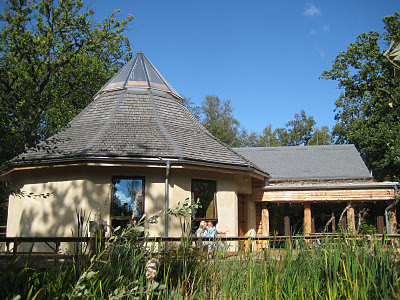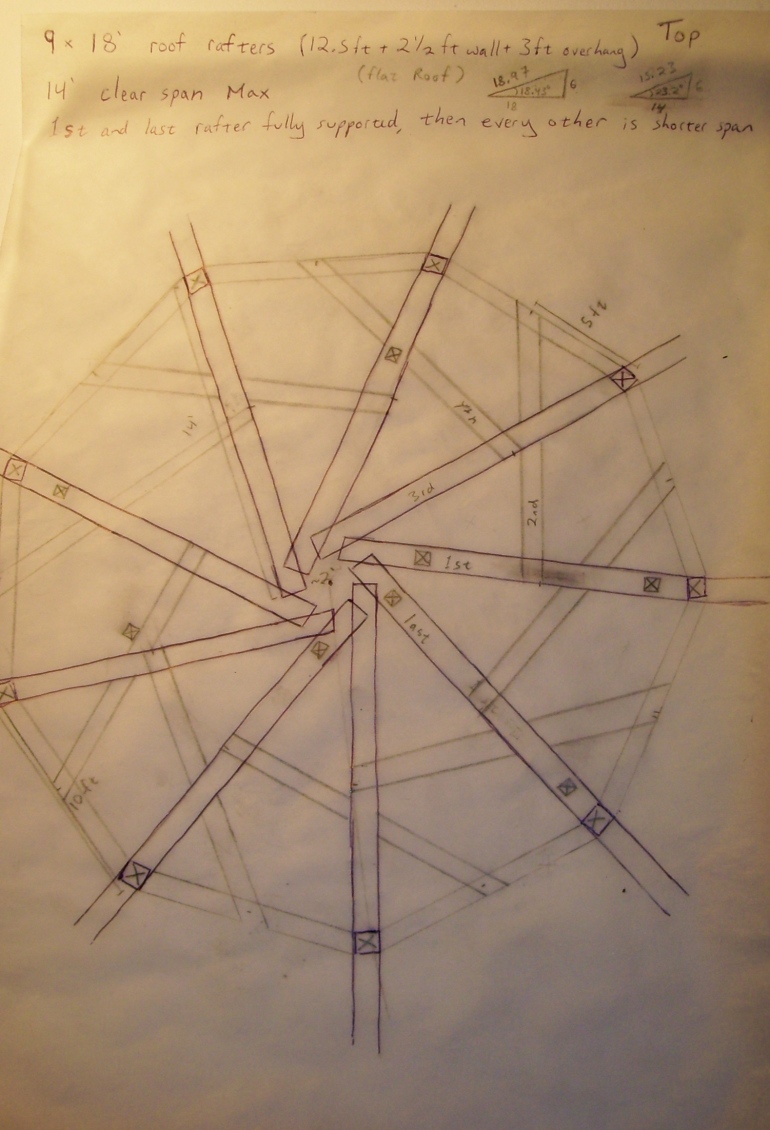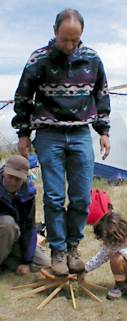I am becoming more and more enamored with the idea of a reciprocal roof for my own round cob/straw bale home. But I am also hungry to learn more about the physics, strengths, and weaknesses of these beautiful, elegant, yet simple roofs.
Here are some pictures of a beautiful double reciprocal roof I found. These are of a double reciprocal roof built somewhere in Europe I believe in partnership with the Lincoln School of Architecture. The pictures are taken from the Lincoln School of architecture blog and the Hill Holt Wood community blog.




After seeing these I had to try designing my own roof. Tracing my own, to scale drawing of my round house I drew up a potential roof structure. It started as a simple reciprocal roof but then I started playing with a double reciprocal roof to make the spans shorter. The secondary rafters in my drawing bisect the major rafters and the squares with an X in them are where I was thinking of having posts.

There doesn’t seem to be much literature out there though on these roofs and I have many unanswered questions. I would love to talk to someone who could tell me if making it a double reciprocal roof makes it stronger or not and how much more complex it would be to build a double reciprocal roof. Another unanswered question is how much it matters if all angles are exactly uniform. Would the integrity of the structure be greatly compromised if slightly different diameter, rough sawn beams were used? Or different kinds of wood? Also, it seems that some of the genius of these structures are that they are totally self supporting, so I wonder if adding a few supporting posts somewhat randomly would actually compromise the strength of these structures by making the load less uniform. Or would adding a few supporting posts give more strength to these roofs? What is an ideal pitch for these roofs and how big can your spans be? I would also love to do a living roof but those are known to be quite heavy and in a Northeast climate you have to worry about snow load as well. How much weight can these reciprocal roofs actually take? If anyone knows someone who could answer some of these questions or help me figure out the answers please get me in contact!
My own research has turned up a few promising leads, but not much. The fact that the Lincoln School of Architecture built one of these is hopeful. Perhaps if I contact them I can get in contact with someone who better understands these roofs.
I also found a book called Reciprocal Frame Architecture by Olga Popovic Larsen that could be helpful but looks more like a coffee table book of pretty pictures than a How To book.
Then there is Brian Liloia from the Year of Mud Blog who definitely wins with the most google hits for reciprocal roofs. He built a living roof on a small cob structure, similar to what I hope to build, but I think his may be even smaller.
There is also a book called Building a Low Impact Roundhouse by Tony Wrench that seems to be recommended by some who have built their own reciprocal roofs and have a few good reviews on Amazon. Based on pictures their structure looks like it could be a similar size to what I want to build and is holding a lot of weight: a straw bale insulation layer, then a vapor barrier, and then a living roof. So that is also hopeful!


Lastly, I found a bit of info on the Lama Foundation website that looks promising. Here it looks like they were just playing around with a few small scale models, something I definitely want to do, but one picture in particular caught my eye:

Well, reciprocal roofs are definitely something I will continue to play with and explore. I am captivated by their simple elegance and would love to have one of my own… Like I said, if you find any more resources on these, whether people or print resources, please pass them on to me! Thanks.


I am also doing some research on reciprocal roofs (for building cob) and found your blog. I’m not sure if you have found some more helpful resources since January, but two related posts that you may find instructive are http://www.thatroundhouse.info/reciframes.htm and http://www.livinginthefuture.org/index.php/43. The second is a video of Tony Wrench demonstrating the building of a reciprocal roof.
Happy building!
LikeLike
Thanks Byrd! These look like some good resources that I didn’t manage to find 🙂
LikeLike
I found Reciprocal Frame Architecture on amazon.com and I think it is more than a coffee table book. It lets you look through the pages as a sample and it looks like it has good information in there.
LikeLike
Good to know! I never actually got the book, so I am happy to hear that, especially since there aren’t many resources out there on these roof structures!
LikeLike
I bought the book and found it very useful.
LikeLike
I bought this book, and found it very interesting. It’s quite technical and got me lost in those details, but an architect or engineer will understand all that.
LikeLike
Good to know! Perhaps I will buy it too 🙂
LikeLike
I think building this kind of structure takes a lot of time. Considering its reciprocal design, building this would also mean more workers. If not done in meticulous manner this would not be a success. Luckily, they had the help of Lincoln School of Architecture in building this.
LikeLike
Nop e to both – Tony Wrench calls for doing it in two days! Also, google hobbit house wales to see the beautiful home of Simon Dale and his family – all built with rough logs!
LikeLike
Have a look here http://www.slideshare.net/malditopapanoel/reciprocal-framearchitecture
LikeLike
I found a site where the author covers some of the basic math involved in a reciprocal roof. There is truly method to this madness, and it’s a simple calculation. If you’re going to build one, it’s worth checking out.
http://www.goodnewsfirst.org/?page_id=394
LikeLike
Thanks Monica! This looks super helpful. So glad to be told about this site
LikeLike
We just put up our reciprocal roof in one day on our 6 meter (interior) cob bedroom. I have tons of photos on our FB page, ranchosolymar. We are originally from NH, then ME, now we live, work and own a center for sustainable living on the pacific coast of Mexico, 2 hours south of Puerto Vallarta. We wish you the very best!
LikeLike
6 meters?! So almost 18 feet! Wow! Glad to hear it worked! I would love to see photos but a search on facebook doesn’t seem to bring you up- it takes me to your webpage rather than your facebook group.
LikeLike
I drew up an 18′ gazebo with 6 posts on Sunday (sketchup). Ordered material on Monday. Set posts on Tuesday, set beams on Wednesday, purlins and sheeting on Thursday and shingles on Friday. I had a week off from work. This was done with 2 people. My wife and I set the beams off a ladder. Beams were 3.5 x 10 glulams. Posts are free standing – no tie between. Opening is approx 44″ across. Had about 3′ of snow on it this year with no trouble.
LikeLike
Awesome!! Thanks for sharing!
Would love to see pictures if you have them 🙂
LikeLike
I have some pictures but don’t see any way to upload them to the site. I built it last year and, literally, today added the final cupola. Still not sure on scale of the cupola – but it will work for now. I’ll try and upload to my website and get a link to them.
LikeLike
Hmm, yes, I don’t know if you can upload photos to the comments. If you have a website to post them on and could link to them that would be best as I bet other readers may want to take a look!
LikeLike
Ok – below is a link to a more full description and some images of my fire pit.
http://www.buildmt.com/featured/reciprocal-frame-roof/
LikeLike
Thanks! A lot of detail here. This is GREAT! And nice job- looks like some beautiful craftsmanship. Very inspiring 🙂
LikeLike
I’m also looking at the same information. searching “Reciprocal frames” gives a lot of good links. The guys who research this call them frames. Other search terms “reciprocal structures” and “Free-form design”.
I’ve looked at a lot of links and somehow didn’t find some of the ones you and others have listed. Thanks.
Another link with some design data and a super nice looking house.
http://simondale.net/house/frame.htm
I found the book,”Reciprocal Frame Architecture by Olga Popovic Larsen” online. It looks fairly complete with a quick look through.
I found these pdf’s online.
The Principle of Structural Reciprocity, Pugnale, Alberto; Parigi, Dario; Kirkegaard, Poul Henning; Sassone, Mario SASSONE
Click to access The_Principle_of_Structural_Reciprocity.pdf
Three-dimensional Reciprocal Structures: Morphology, Concepts, Generative Rules
Parigi, Dario; Pugnale, Alberto
Click to access Three_dimensional_Reciprocal_Structures_Morphology_Concepts_Generative_Rules.pdf
Towards Free-Form Kinetic Structures
Parigi, Dario; Kirkegaard, Poul Henning
Click to access Towards_Free_Form_Kinetic_Structures.pdf
nexorades a family of interwoven space structures
Click to access 326512.pdf
Reciprocal frame structures. Popovic, Olga (1996) Reciprocal frame structures. PhD thesis, University of Nottingham
I think this is the link. It won’t download right now. It’s a big file
http://etheses.nottingham.ac.uk/1494/
A lot of these are too engineerish for most but even so looking at a lot of papers and you soon begin to get the gist of what they’re talking about.
I’m going to build a reciprocal roof this winter. It’s going to cover an underground shed with three feet of earth on top. My place got blown away by a tornado and by God it will never happen again.
One thing I noticed is that people say that all the forces are downward and that supports are not needed to hold the structure together. I DO NOT believe this and hope others will not either. It seems that the poles are held together by frictional forces. If you don’t believe this try to make a reciprocal roof with pencils or toothpicks. Difficult. There’s not enough friction to keep them from sliding. If they slide when small how can they not when bigger? My take is they have more weight when large poles are used instead of small sticks increasing frictional force. As the roof is loaded it increases the frictional force. So my roof will have strong connections at the top, bracing to hold the lower parts of the roof poles together and to keep them apart from each other. I think when people nail the rafters to the poles plus the frictional force from the downward load on the roof it holds together fine but I’m not taking any chances.
You asked about square poles. I believe you have to notch them or so someone said. Can’t remember where. Some people have used square. Remember that after weight is on the structure a round pole with have a sharp round edge frictionally (not sure this is a word) digging into the one below and the one above. Square? Not sure.
You asked if extra braces would help. I can see no reason why they would not. I plan on using them. If weight from one pole is transferred to the brace/column then it takes some load off the whole structure because the force is distributed across all the members. So all the forces would be less.
The best way to test your roof is to build one. Before computers all engineers build scale models and loaded them down with two or three times the weight to test. Example. I’m going to build a model 1 foot actual size to 1 inch scale size. If you have 24 feet of room the model would be 24 inches. Wood as a material at 1 inch is just the same as at 1 foot. In my case the smallest poles will be 8 inches. That’s about 0.666 inches but I’m going to use 0.5 inch poles to test. I’ll build the exact model scaled then I’m going to load it with 6 inches of dirt. Twice the load. Then three times load and maybe more until it breaks. If you test a model at three times the load it should be well over any strength you need.
LikeLike
Another resource to add! an awesome time lapse video of a reciprocal roof going up: http://timberhomesllc.com/a-song-to-celebrate-a-reciprocal-roof-pavilion/
LikeLike